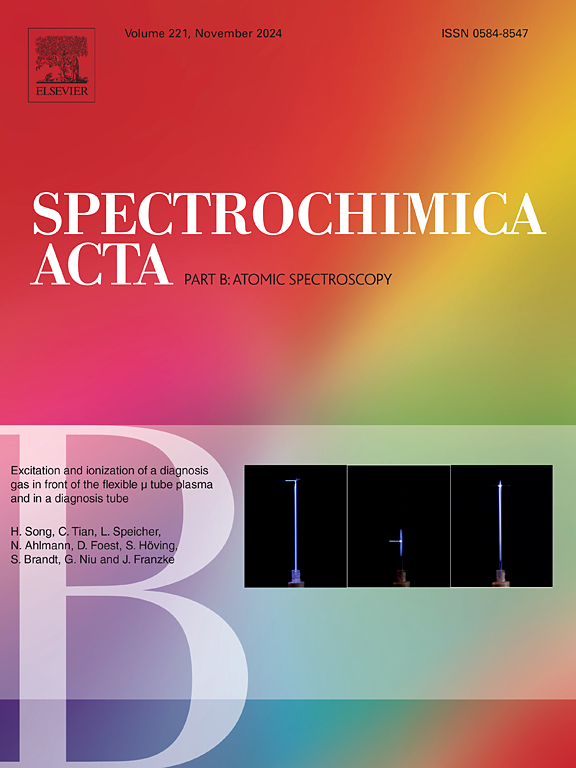Development and characterization of a high-sensitivity and high-throughput in-house multimodal TXRF/GIXRF mobile spectrometer
IF 3.8
2区 化学
Q1 SPECTROSCOPY
引用次数: 0
Abstract
Total-reflection X-ray Fluorescence (TXRF) and Grazing Incidence X-ray Fluorescence (GIXRF) techniques are non-destructive methods widely applied across diverse research domains. These methodologies capitalize on constructive and destructive interferences between grazing incident and reflected X-rays to generate an X-ray standing wave (XSW) field, optimizing excitation conditions at interfaces and reflective surfaces and minimizing background noise thus enabling highly sensitive depth-resolved specific analysis at the nanometer regime. High precision tuning of the angle of incidence allows detection of thin layers down to the nanometer scale. While TXRF is established in global laboratories, advanced methods like GIXRF have predominantly remained confined to synchrotron radiation facilities due to the need of high flux monochromatic X-ray sources as well as high level of control in the beam direction and its divergence. Successful implementation of lab-based GIXRF instruments is furthermore constrained by data evaluation capabilities, critical for accurately modelling experimental datasets and determining the effective solid angles of detection, that vary in a not trivial fashion with the incident angles.
This article showcases the development of a fully functional high sensitivity and high through-put mobile TXRF/GIXRF system assembled in-house, utilizing high-efficiency new-generation sources, high-efficiency silicon detectors and a high-precision motorized rotational stage. The system's capabilities have been tested on a range of well-characterized samples in both total reflection and grazing incidence geometries. This approach allows for the detection of contaminants in the parts per billion range and the extraction of the depth profile of a layered sample in the nanometer range. Future improvements could focus on adapting the developed system for application on imperfect samples surfaces in cultural heritage studies.

高灵敏度高通量多模态TXRF/GIXRF移动光谱仪的研制与表征
全反射x射线荧光(TXRF)和掠射x射线荧光(GIXRF)技术是广泛应用于不同研究领域的非破坏性方法。这些方法利用入射x射线和反射x射线之间的建设性和破坏性干涉来产生x射线驻波(XSW)场,优化界面和反射表面的激发条件,最大限度地减少背景噪声,从而在纳米范围内实现高度敏感的深度分辨特定分析。入射角的高精度调谐允许检测到纳米尺度的薄层。虽然TXRF已在全球实验室建立,但由于需要高通量单色x射线源以及对光束方向及其发散的高度控制,像GIXRF这样的先进方法主要仍然局限于同步辐射设施。此外,基于实验室的GIXRF仪器的成功实施还受到数据评估能力的限制,数据评估能力对于准确建模实验数据集和确定有效的探测立体角至关重要,而探测立体角随着入射角的变化而变化。本文展示了一种全功能、高灵敏度、高通量的移动TXRF/GIXRF系统的开发,该系统采用了高效的新一代光源、高效的硅探测器和高精度的电动旋转平台。该系统的性能已经在全反射和掠入射几何形状的一系列特征良好的样品上进行了测试。这种方法允许在十亿分之一范围内检测污染物,并在纳米范围内提取分层样品的深度剖面。未来的改进可以集中在使开发的系统适应文化遗产研究中不完美样品表面的应用。
本文章由计算机程序翻译,如有差异,请以英文原文为准。
求助全文
约1分钟内获得全文
求助全文
来源期刊
CiteScore
6.10
自引率
12.10%
发文量
173
审稿时长
81 days
期刊介绍:
Spectrochimica Acta Part B: Atomic Spectroscopy, is intended for the rapid publication of both original work and reviews in the following fields:
Atomic Emission (AES), Atomic Absorption (AAS) and Atomic Fluorescence (AFS) spectroscopy;
Mass Spectrometry (MS) for inorganic analysis covering Spark Source (SS-MS), Inductively Coupled Plasma (ICP-MS), Glow Discharge (GD-MS), and Secondary Ion Mass Spectrometry (SIMS).
Laser induced atomic spectroscopy for inorganic analysis, including non-linear optical laser spectroscopy, covering Laser Enhanced Ionization (LEI), Laser Induced Fluorescence (LIF), Resonance Ionization Spectroscopy (RIS) and Resonance Ionization Mass Spectrometry (RIMS); Laser Induced Breakdown Spectroscopy (LIBS); Cavity Ringdown Spectroscopy (CRDS), Laser Ablation Inductively Coupled Plasma Atomic Emission Spectroscopy (LA-ICP-AES) and Laser Ablation Inductively Coupled Plasma Mass Spectrometry (LA-ICP-MS).
X-ray spectrometry, X-ray Optics and Microanalysis, including X-ray fluorescence spectrometry (XRF) and related techniques, in particular Total-reflection X-ray Fluorescence Spectrometry (TXRF), and Synchrotron Radiation-excited Total reflection XRF (SR-TXRF).
Manuscripts dealing with (i) fundamentals, (ii) methodology development, (iii)instrumentation, and (iv) applications, can be submitted for publication.

 求助内容:
求助内容: 应助结果提醒方式:
应助结果提醒方式:


